Mostrar el registro sencillo del ítem
dc.contributor.author
Pabon, Nicolas

dc.contributor.author
Xia, Yan
dc.contributor.author
Estabrooks, Samuel K.
dc.contributor.author
Ye, Zhaofeng
dc.contributor.author
Herbrand, Amanda K.
dc.contributor.author
Süß, Evelyn
dc.contributor.author
Biondi, Ricardo Miguel

dc.contributor.author
Assimon, Victoria A.
dc.contributor.author
Gestwicki, Jason E.
dc.contributor.author
Brodsky, Jeffrey L.
dc.contributor.author
Camacho, Carlos

dc.contributor.author
Bar Joseph, Ziv

dc.date.available
2019-10-29T21:32:33Z
dc.date.issued
2018-12
dc.identifier.citation
Pabon, Nicolas; Xia, Yan; Estabrooks, Samuel K.; Ye, Zhaofeng; Herbrand, Amanda K.; et al.; Predicting protein targets for drug-like compounds using transcriptomics; Public Library of Science; Plos Computational Biology; 14; 12; 12-2018; 1-24
dc.identifier.issn
1553-734X
dc.identifier.uri
http://hdl.handle.net/11336/87626
dc.description.abstract
An expanded chemical space is essential for improved identification of small molecules for emerging therapeutic targets. However, the identification of targets for novel compounds is biased towards the synthesis of known scaffolds that bind familiar protein families, limiting the exploration of chemical space. To change this paradigm, we validated a new pipeline that identifies small molecule-protein interactions and works even for compounds lacking similarity to known drugs. Based on differential mRNA profiles in multiple cell types exposed to drugs and in which gene knockdowns (KD) were conducted, we showed that drugs induce gene regulatory networks that correlate with those produced after silencing protein-coding genes. Next, we applied supervised machine learning to exploit drug-KD signature correlations and enriched our predictions using an orthogonal structure-based screen. As a proof-of-principle for this regimen, top-10/top-100 target prediction accuracies of 26% and 41%, respectively, were achieved on a validation of set 152 FDA-approved drugs and 3104 potential targets. We then predicted targets for 1680 compounds and validated chemical interactors with four targets that have proven difficult to chemically modulate, including non-covalent inhibitors of HRAS and KRAS. Importantly, drug-target interactions manifest as gene expression correlations between drug treatment and both target gene KD and KD of genes that act up- or down-stream of the target, even for relatively weak binders. These correlations provide new insights on the cellular response of disrupting protein interactions and highlight the complex genetic phenotypes of drug treatment. With further refinement, our pipeline may accelerate the identification and development of novel chemical classes by screening compound-target interactions.
dc.format
application/pdf
dc.language.iso
eng
dc.publisher
Public Library of Science

dc.rights
info:eu-repo/semantics/openAccess
dc.rights.uri
https://creativecommons.org/licenses/by/2.5/ar/
dc.subject
small compound
dc.subject
target prediction
dc.subject
transcriptomics
dc.subject.classification
Bioquímica y Biología Molecular

dc.subject.classification
Ciencias Biológicas

dc.subject.classification
CIENCIAS NATURALES Y EXACTAS

dc.title
Predicting protein targets for drug-like compounds using transcriptomics
dc.type
info:eu-repo/semantics/article
dc.type
info:ar-repo/semantics/artículo
dc.type
info:eu-repo/semantics/publishedVersion
dc.date.updated
2019-10-22T17:53:59Z
dc.journal.volume
14
dc.journal.number
12
dc.journal.pagination
1-24
dc.journal.pais
Estados Unidos

dc.journal.ciudad
San Francisco
dc.description.fil
Fil: Pabon, Nicolas. University of Pittsburgh; Estados Unidos
dc.description.fil
Fil: Xia, Yan. University of Carnegie Mellon; Estados Unidos
dc.description.fil
Fil: Estabrooks, Samuel K.. University of Pittsburgh; Estados Unidos
dc.description.fil
Fil: Ye, Zhaofeng. Tsinghua University; China
dc.description.fil
Fil: Herbrand, Amanda K.. Goethe Universitat Frankfurt; Alemania
dc.description.fil
Fil: Süß, Evelyn. Goethe Universitat Frankfurt; Alemania
dc.description.fil
Fil: Biondi, Ricardo Miguel. Consejo Nacional de Investigaciones Científicas y Técnicas. Oficina de Coordinación Administrativa Parque Centenario. Instituto de Investigación en Biomedicina de Buenos Aires - Instituto Partner de la Sociedad Max Planck; Argentina. Goethe Universitat Frankfurt; Alemania
dc.description.fil
Fil: Assimon, Victoria A.. University of California; Estados Unidos
dc.description.fil
Fil: Gestwicki, Jason E.. University of California; Estados Unidos
dc.description.fil
Fil: Brodsky, Jeffrey L.. University of Pittsburgh; Estados Unidos
dc.description.fil
Fil: Camacho, Carlos. University of Pittsburgh; Estados Unidos
dc.description.fil
Fil: Bar Joseph, Ziv. University of Carnegie Mellon; Estados Unidos
dc.journal.title
Plos Computational Biology

dc.relation.alternativeid
info:eu-repo/semantics/altIdentifier/doi/http://dx.doi.org/10.1371/journal.pcbi.1006651
dc.relation.alternativeid
info:eu-repo/semantics/altIdentifier/url/journals.plos.org/ploscompbiol/article?id=10.1371/journal.pcbi.1006651
Archivos asociados
